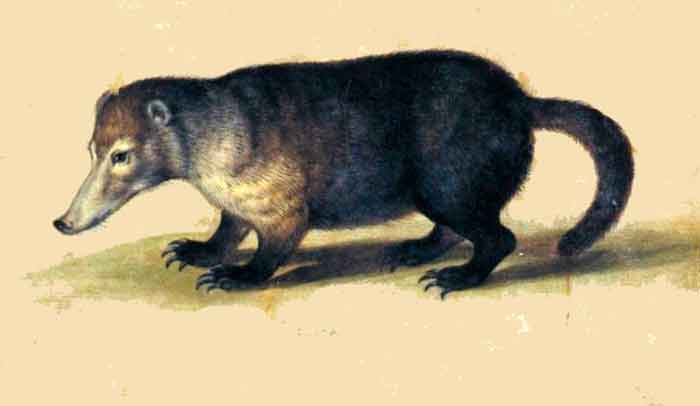
Superregnum: Eukaryota
Cladus: Unikonta
Cladus: Opisthokonta
Cladus: Holozoa
Regnum: Animalia
Subregnum: Eumetazoa
Cladus: Bilateria
Cladus: Nephrozoa
Superphylum: Deuterostomia
Phylum: Chordata
Subphylum: Vertebrata
Infraphylum: Gnathostomata
Megaclassis: Osteichthyes
Cladus: Sarcopterygii
Cladus: Rhipidistia
Cladus: Tetrapodomorpha
Cladus: Eotetrapodiformes
Cladus: Elpistostegalia
Superclassis: Tetrapoda
Cladus: Reptiliomorpha
Cladus: Amniota
Cladus: Synapsida
Cladus: Eupelycosauria
Cladus: Sphenacodontia
Cladus: Sphenacodontoidea
Cladus: Therapsida
Cladus: Theriodontia
Cladus: Cynodontia
Cladus: Eucynodontia
Cladus: Probainognathia
Cladus: Prozostrodontia
Cladus: Mammaliaformes
Classis: Mammalia
Subclassis: Trechnotheria
Infraclassis: Zatheria
Supercohors: Theria
Cohors: Eutheria
Infraclassis: Placentalia
Cladus: Boreoeutheria
Superordo: Laurasiatheria
Cladus: Scrotifera
Cladus: Ferungulata
Cladus: Ferae
Cladus: Pancarnivora
Cladus: Carnivoramorpha
Cladus: Carnivoraformes
Ordo: Carnivora
Subordo: Caniformia
Infraordo: Arctoidea
Superfamilia: Musteloidea
Familia: Procyonidae
Subfamilia: Procyoninae
Genus: Nasuella
Species: Nasuella olivacea
Subspecies: N. o. olivacea – N. o. quitensis
Name
Nasuella olivacea (J. E. Gray, 1865)
References
Nasuella olivacea in Mammal Species of the World.
Wilson, Don E. & Reeder, DeeAnn M. (Editors) 2005. Mammal Species of the World – A Taxonomic and Geographic Reference. Third edition. ISBN 0-8018-8221-4.
IUCN: Nasuella olivacea (Gray, 1865) (Data Deficient)
Vernacular names
Deutsch: Bergnasenbär
English: Mountain Coati
español: Coatí andino
magyar: Kis ormányosmedve
português: Quati-das-montanhas
The western mountain coati or western dwarf coati (Nasuella olivacea) is a small procyonid, found in cloud forest and páramo at altitudes of 1,300–4,250 metres (4,270–13,940 ft) in the Andes of Colombia and Ecuador.[2] A population discovered in the Apurímac–Cuzco region of southern Peru (more than 1,000 km or 620 mi south of the previous distribution limit) has tentatively been identified as the western mountain coati, but may represent an undescribed taxon.[3]
Until 2009, the western mountain coati (then simply known as the mountain coati) usually included the eastern mountain coati as a subspecies, but that species is overall smaller, somewhat shorter-tailed on average, has markedly smaller teeth, a paler olive-brown pelage, and usually a dark mid-dorsal stripe on the back (versus more rufescent or blackish, and usually without a dark mid-dorsal stripe in the western mountain coati).[2] When the two were combined, they were rated as Data Deficient by the IUCN, but following the split the western mountain coati is considered Near Threatened.[1] After a genetic analysis in 2020, the American Society of Mammalogists currently considers N. meridensis a synonym of N. olivacea.[4]
There are two subspecies of the western mountain coati: N. o. olivacea and the slightly smaller and darker N. o. quitensis with less distinct rings on the tail.[2] The former is known from Colombia and the latter from Ecuador, but the exact distribution limit between the two is not known.[2]
References
González-Maya, J.F.; Reid, F.; Helgen, K. (2016). "Nasuella olivacea". IUCN Red List of Threatened Species. 2016: e.T72261737A45201571. doi:10.2305/IUCN.UK.2016-1.RLTS.T72261737A45201571.en. Retrieved 19 November 2021.
Helgen, K. M., R. Kays, L. E. Helgen, M. T. N. Tsuchiya-Jerep, C. M. Pinto, K. P. Koepfli, E. Eizirik, and J. E. Maldonado (2009). Taxonomic boundaries and geographic distributions revealed by an integrative systematic overview of the mountain coatis, Nasuella (Carnivora: Procyonidae). Small Carnivore Conservation. 41: 65–74
Pacheco, V., R. Cadenillas, E. Salas, C. Tello, and H. Zeballos (2009). Diversidad y endemismo de los mamíferos del Perú/Diversity and endemism of Peruvian mammals. Rev. Peru. Biol. 16(1): 5-32.
Ruiz-García, M., Jaramillo, M. F., Cáceres-Martínez, C. H., & Shostell, J. M. (2020). The phylogeographic structure of the mountain coati (Nasuella olivacea; Procyonidae, Carnivora), and its phylogenetic relationships with other coati species (Nasua nasua and Nasua narica) as inferred by mitochondrial DNA. Mammalian Biology, 1-28.
Retrieved from "http://en.wikipedia.org/"
All text is available under the terms of the GNU Free Documentation License

